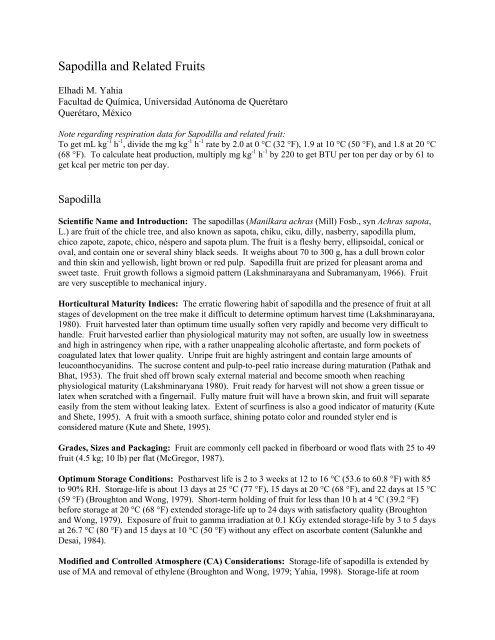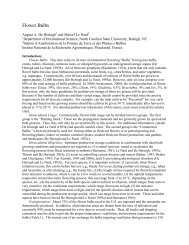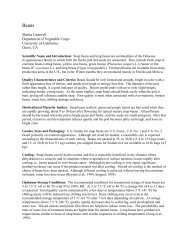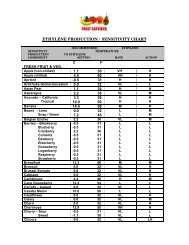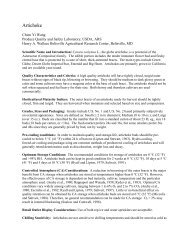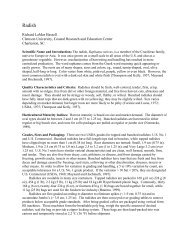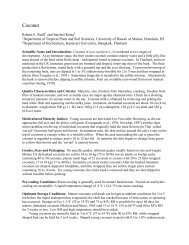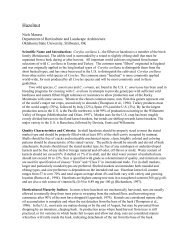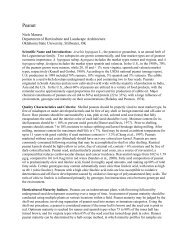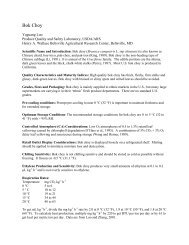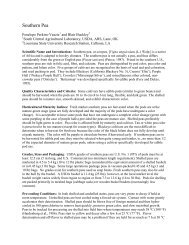Sapodilla and related fruit
Sapodilla and related fruit
Sapodilla and related fruit
You also want an ePaper? Increase the reach of your titles
YUMPU automatically turns print PDFs into web optimized ePapers that Google loves.
<strong>Sapodilla</strong> <strong>and</strong> Related FruitsElhadi M. YahiaFacultad de Química, Universidad Autónoma de QuerétaroQuerétaro, MéxicoNote regarding respiration data for <strong>Sapodilla</strong> <strong>and</strong> <strong>related</strong> <strong>fruit</strong>:To get mL kg -1 h -1 , divide the mg kg -1 h -1 rate by 2.0 at 0 °C (32 °F), 1.9 at 10 °C (50 °F), <strong>and</strong> 1.8 at 20 °C(68 °F). To calculate heat production, multiply mg kg -1 h -1 by 220 to get BTU per ton per day or by 61 toget kcal per metric ton per day.<strong>Sapodilla</strong>Scientific Name <strong>and</strong> Introduction: The sapodillas (Manilkara achras (Mill) Fosb., syn Achras sapota,L.) are <strong>fruit</strong> of the chicle tree, <strong>and</strong> also known as sapota, chiku, ciku, dilly, nasberry, sapodilla plum,chico zapote, zapote, chico, néspero <strong>and</strong> sapota plum. The <strong>fruit</strong> is a fleshy berry, ellipsoidal, conical oroval, <strong>and</strong> contain one or several shiny black seeds. It weighs about 70 to 300 g, has a dull brown color<strong>and</strong> thin skin <strong>and</strong> yellowish, light brown or red pulp. <strong>Sapodilla</strong> <strong>fruit</strong> are prized for pleasant aroma <strong>and</strong>sweet taste. Fruit growth follows a sigmoid pattern (Lakshminarayana <strong>and</strong> Subramanyam, 1966). Fruitare very susceptible to mechanical injury.Horticultural Maturity Indices: The erratic flowering habit of sapodilla <strong>and</strong> the presence of <strong>fruit</strong> at allstages of development on the tree make it difficult to determine optimum harvest time (Lakshminarayana,1980). Fruit harvested later than optimum time usually soften very rapidly <strong>and</strong> become very difficult toh<strong>and</strong>le. Fruit harvested earlier than physiological maturity may not soften, are usually low in sweetness<strong>and</strong> high in astringency when ripe, with a rather unappealing alcoholic aftertaste, <strong>and</strong> form pockets ofcoagulated latex that lower quality. Unripe <strong>fruit</strong> are highly astringent <strong>and</strong> contain large amounts ofleucoanthocyanidins. The sucrose content <strong>and</strong> pulp-to-peel ratio increase during maturation (Pathak <strong>and</strong>Bhat, 1953). The <strong>fruit</strong> shed off brown scaly external material <strong>and</strong> become smooth when reachingphysiological maturity (Lakshminaryana 1980). Fruit ready for harvest will not show a green tissue orlatex when scratched with a fingernail. Fully mature <strong>fruit</strong> will have a brown skin, <strong>and</strong> <strong>fruit</strong> will separateeasily from the stem without leaking latex. Extent of scurfiness is also a good indicator of maturity (Kute<strong>and</strong> Shete, 1995). A <strong>fruit</strong> with a smooth surface, shining potato color <strong>and</strong> rounded styler end isconsidered mature (Kute <strong>and</strong> Shete, 1995).Grades, Sizes <strong>and</strong> Packaging: Fruit are commonly cell packed in fiberboard or wood flats with 25 to 49<strong>fruit</strong> (4.5 kg; 10 lb) per flat (McGregor, 1987).Optimum Storage Conditions: Postharvest life is 2 to 3 weeks at 12 to 16 °C (53.6 to 60.8 °F) with 85to 90% RH. Storage-life is about 13 days at 25 °C (77 °F), 15 days at 20 °C (68 °F), <strong>and</strong> 22 days at 15 °C(59 °F) (Broughton <strong>and</strong> Wong, 1979). Short-term holding of <strong>fruit</strong> for less than 10 h at 4 °C (39.2 °F)before storage at 20 °C (68 °F) extended storage-life up to 24 days with satisfactory quality (Broughton<strong>and</strong> Wong, 1979). Exposure of <strong>fruit</strong> to gamma irradiation at 0.1 KGy extended storage-life by 3 to 5 daysat 26.7 °C (80 °F) <strong>and</strong> 15 days at 10 °C (50 °F) without any effect on ascorbate content (Salunkhe <strong>and</strong>Desai, 1984).Modified <strong>and</strong> Controlled Atmosphere (CA) Considerations: Storage-life of sapodilla is extended byuse of MA <strong>and</strong> removal of ethylene (Broughton <strong>and</strong> Wong, 1979; Yahia, 1998). Storage-life at room
Postharvest Pathology: The most important pests include the annona seed borer <strong>and</strong> the ambrosiabeetle. The annona seed borer lays eggs in the seeds of very young <strong>fruit</strong>s; insects develop in the seeds<strong>and</strong> emerge as adults when the <strong>fruit</strong> matures.Mamey AppleScientific Name <strong>and</strong> Introduction: Mamey apple, also know as mamey <strong>and</strong> zapote (Mammeaamericana), is a <strong>fruit</strong> of about 300 to 500 g with a peach-like flavor, round with a thick brown leatheryskin containing one large single seed surrounded by a thin layer of yellow flesh. The <strong>fruit</strong> is a drupeabout the shape <strong>and</strong> size of an orange, with a russet surface covered with small spots. The rind is tough,about 4-mm thick, <strong>and</strong> the flesh is yellow. The endocarp is yellow, about 2- to 5-mm thick <strong>and</strong> is fusedwith the testa.Chilling Sensitivity: Chilling injury symptoms include failure to ripen, accelerated softening,development of brown spots in pulp, <strong>and</strong> development of off-flavors <strong>and</strong> aromas.Ethylene Production: Ethylene production at 27 °C (80.6 °F) is up to 400 µL kg -1 h -1 , among the highestof all <strong>fruit</strong>s (Akamine <strong>and</strong> Goo, 1978).Respiration Rates: Mamey apple is a climacteric <strong>fruit</strong>. The respiration rate at 27 °C (80.6 °F) is 28 to40 mg (14 to 20 µL) CO 2 kg -1 h -1 (Akamine <strong>and</strong> Goo, 1978).White SapoteScientific Name <strong>and</strong> Introduction: White sapote or zapote blanco (Casimiroa edulis llave & Lex) isalso known as matasano in Spanish meaning “killing healthy person” due to the presence of the glucosidecasimirosine, mainly in seeds but also in bark <strong>and</strong> leaves. This compound has sedative effects, inducessleep, <strong>and</strong> can also calm rheumatic pains. The <strong>fruit</strong> is dull-green to greenish-yellow, subglobose to oblate,<strong>and</strong> 5 to 10 cm in diameter. The skin is very thin <strong>and</strong> the flesh is cream colored to yellowish, soft <strong>and</strong>very sweet, with 1 to 5 large, hard, avoid seeds. The <strong>fruit</strong> is round, oval or ovoid in shape. Greenskinnedvarieties have white flesh <strong>and</strong> yellow-skinned varieties have yellow flesh. The skin is thin <strong>and</strong>smooth <strong>and</strong> the flesh has a custard-like texture <strong>and</strong> sweet flavor.Quality Characteristics <strong>and</strong> criteria: Quality <strong>fruit</strong> are yellow to yellowish green <strong>and</strong> 60 to 120 mm indiameter (McGregor, 1987).Horticultural Maturity Indices: White sapote <strong>fruit</strong> ripen after 6 to 9 mo from bloom. Fruit color atmaturity ranges from apple-green to orange-yellow, depending on cultivar. Overripe <strong>fruit</strong> are commonlypungent with an unpleasant flavor. Fruit taste best when tree-ripened, but should be picked beforeripening. Fruit should be h<strong>and</strong>led very carefully during harvesting because they are easily bruised,turning the skin black <strong>and</strong> the flesh beneath it bitter.Optimum Storage Conditions: Storage-life is 2 to 3 weeks at 19 to 21°C (66.2 to 69.8 °F) with 85 to90% RH.Postharvest Pathology: White sapote is resistant to Phytophthora <strong>and</strong> to Armillaria, but some cultivarscan be attacked by <strong>fruit</strong> flies.
Black SapoteScientific Name <strong>and</strong> Introduction: Black sapote (Diospyros dignya) resembles a large, round greentomato, is 200 to 250 g, 5- to 12-cm in diameter with a thin skin, green color changing to brown or blackwhen ripe. During ripening, pulp becomes soft <strong>and</strong> black in color.Optimum Storage Conditions <strong>and</strong> Chilling Sensitivity: Black sapote is chilling sensitive. Fruit held at15, 20 or 25 °C (59, 68, or 77 °F) for up to 7, 10, or 15 days, <strong>and</strong> then transferred to 25 °C (77 °F),ripened normally (Miller et al., 1997). Fruit held at 10 °C (50 °F) for 7 days <strong>and</strong> then transferred to 25 °C(77 °F) also ripened normally. However, some <strong>fruit</strong> held at 10 °C (50 °F) for 10 or 15 days showedabnormal ripening, <strong>and</strong> most <strong>fruit</strong> stored at 1 or 5 °C (33.8 to 41 °F) did not ripen normally or failed toripen regardless of storage duration. Black sapote will tolerate irradiation at 0.15 kGy, but abnormalripening will likely occur with some <strong>fruit</strong> when treated at 0.3 kGy (Miller et al., 1997).LucumaScientific Name <strong>and</strong> Introduction: The lucuma, lucumo, lucmo, lucma, rucma, or mamon (Lucumaobovata, HBK) is round or ovate, green on the surface, with yellow flesh <strong>and</strong> mealy texture. Fruit areabout 7 cm long. The lucuma is a climacteric <strong>fruit</strong>. It has a low water content (64 to 72%) <strong>and</strong> higheramounts of riboflavin, niacin, <strong>and</strong> ascorbate than apples or bananas (Wenkam <strong>and</strong> Miller, 1965; Lopez,1984).Horticultural Maturity Indices: The maturity index commonly used is a change of peel color fromgreen to yellow. However, variability exists in peel <strong>and</strong> pulp color ranging from green to yellowish-greenpeel, <strong>and</strong> light-yellow to orange-yellow pulp (Lizana, 1980). SSC can be used as a harvest index, but<strong>fruit</strong> have a dense <strong>and</strong> dry pulp. Therefore, to measure SSC, it is necessary to disrupt pulp by mechanicalmeans <strong>and</strong> dilute with water. If pre-mechanical disruption of cells is not undertaken, apparent SSCcontent will appear lower than the true value (Lizana et al., 1986).A classification of five stages of maturity was developed according to peel <strong>and</strong> pulp color, texture,SSC <strong>and</strong> respiration (Lizana, 1980). The classes in relation to peel <strong>and</strong> pulp color are:Class Peel color Pulp color1 light-yellow light-yellow2 light-green creamy-yellow3 yellow-green yellow4 green-yellow dark-yellow5 green-yellow orange-yellowFruit ripened on the tree usually become soft <strong>and</strong> very fragile (Lizana, 1980). The pulp of the <strong>fruit</strong> isvery dry when ripe (Lizana, 1980). Intense respiratory activity <strong>and</strong> sugar accumulation occur duringripening (Lizana et al., 1986).References:Akamine, E.K. <strong>and</strong> T. Goo. 1978. Respiration <strong>and</strong> ethylene production in Mammee apple (Mammeaamericana L.). J. Amer. Soc. Hort. Sci. 103:308-310.Bojappa, K.K.M. <strong>and</strong> T.V. Reddy. 1990. Postharvest treatments to extend the shelf-life of sapota <strong>fruit</strong>.Acta Hort. 269:391.Broughton, W.J. <strong>and</strong> H.C. Wong. 1979. Storage conditions <strong>and</strong> ripening of chiku <strong>fruit</strong>s Achras sapota L.
Sci. Hort. 10:377-385.Chundawat, B.S. 1991. Postharvest h<strong>and</strong>ling <strong>and</strong> marketing of sapota <strong>fruit</strong>s. Natl. Sem. Opt. Prod. Util.Sapota. October 1991, Navsari, Gujarat, India.Das, R.C. <strong>and</strong> S.K. Mahapatra. 1977. Effect of growth substances <strong>and</strong> fungicidal wax emulsion onripening of sapota. Prog. Hort. 8:75.Ingle, G.S., D.M. Khedkar <strong>and</strong> R.S. Dabhade. 1982. Ripening studies in sapota <strong>fruit</strong>. Indian Food Packer36:72-77.Kader, A. A. (ed). 1992. Postharvest technology of horticultural crops. Second edition, Univ. Calif., Div.Agric. Nat. Res., Pub. No. 3311.Kute, L.S. <strong>and</strong> M.B. Shete. 1995. Sapota (<strong>Sapodilla</strong>). In: D.K. Salunkhe <strong>and</strong> S.S. Kadam (eds) H<strong>and</strong>bookof Fruit Science <strong>and</strong> Technology, pp. 475-484, Marcel Dekker, Inc., NY.Lakshminarayana S. 1980. <strong>Sapodilla</strong> <strong>and</strong> prickly pear. In: S. Nagy <strong>and</strong> P.E. Shaw (eds) Tropical <strong>and</strong>Subtropical Fruits. Composition, Properties <strong>and</strong> Uses. AVI Pub, Westport CT., pp. 415-441.Lakshminarayana S. <strong>and</strong> H. Subramanyam. 1966. Physical, chemical <strong>and</strong> physiological changes in sapota<strong>fruit</strong> (Achras sapota L.) during development <strong>and</strong> ripening. J. Sci. Food Sci. Technol. (Mysore) 3:15-154.Lizana, L.A. 1980. Lucuma. In: S. Nagy, P.E. Shaw <strong>and</strong> W.F. Wardowski (eds) Fruits of Tropical <strong>and</strong>Subtropical Origin. Florida Science Source, Inc., Lake Alfred FL, pp. 373-380.Lizana, L.A., G. Reginato <strong>and</strong> J.C. Lav<strong>and</strong>eros. 1986. Characterization of the maturation of the lucuma(Lucuma bifera Mol., L. Obovata H.B.K.)., Proc. Interam. Soc. Trop. Hortic. 30:105-10 (In Spanish).Lopez, C. 1984. Cultivation of the lucumo <strong>and</strong> its industrialization. Rev. Campesino 115:38-53 (InSpanish).McGregor, B.M. 1987. Tropical products transport h<strong>and</strong>book. USDA Office Trans., Agric. Hndb. No.688.Miller, W.R., J.L. Shari <strong>and</strong> E. Baldwin. 1997. Quality of irradiated <strong>and</strong> non-irradiated black sapote(Diospyros digyna Jacq.) after storage <strong>and</strong> ripening. Proc. Fla. State Hort. Soc. 110:215-218.Mohamed, S., B. Taufik <strong>and</strong> M.N.A. Karim. 1996. Effects of modified atmosphere packaging on thephysiological characteristics of ciku (Arcas sapota L.) at various storage temperatures. J. Sci. FoodAgric. 70:231-240.Pathak, S. <strong>and</strong> J.V. Bhat. 1952. Studies on the microrganisms associated with Achras sapota. J. Univ.Bombay 20(5):14-18.Pathak, S. <strong>and</strong> J.V. Bhat. 1953. The carbohydrate metabolism of Acras sapota <strong>fruit</strong>. J. Univ. Bombay21(5): 11-16, Section A.Pratt, H.K. <strong>and</strong> D.B. Mendoza Jr. 1980. Fruit development <strong>and</strong> ripening of the star apple (Chrysophyllumcainito L.). HortScience 15:721-722.Salunkhe, D.K. <strong>and</strong> B.B. Desai. 1984. Postharvest biotechnology of <strong>fruit</strong>s. Vol. II. CRC Press, BocaRaton, Fl, pp. 387-396.Shanmugavelu, K. G. Srinivasan <strong>and</strong> V.N.M. Rao. 1971. Influence of etherel (2-chloroethyle phosphonicacid) on ripening of sapota (Achras zapota L.). Hortic Adv. 8:33-36.Wenkam, N.S. <strong>and</strong> C.D. Miller. 1965. Composition of Hawaii <strong>fruit</strong>s. Hawaii Agric. Exp. Sta. Bull. No.135.Yahia, E.M. 1998. Modified/controlled atmospheres for tropical <strong>fruit</strong>s. Hort. Rev. 22:123-183.Acknowledgments: Some of the information included was from the University of Florida website:http://hammock.ifas.ufl.edu/tropical_<strong>fruit</strong>s.htm.


